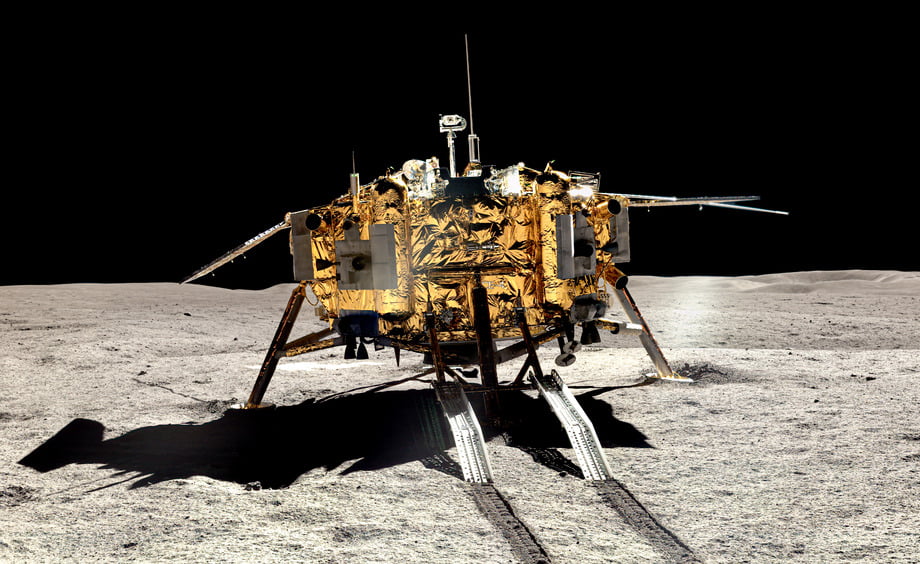China joined humanity’s efforts to explore space quite late. Neither the country’s rockets nor its space technologies could keep up with the pace set by the US and USSR. At best, the PRC was among the top five also-rans as it carried out space missions.
But Chinese space has already cleared the escape velocity. This is clearly visible even through the prism of China’s lunar and Mars programs, where new records are set almost every year. These planetary missions are now a showcase for the effectiveness of Beijing’s space policy.
In this latest installment of our series on Chinese space, we will talk about the PRC’s lunar program.
Four phases of the CLEP lunar program
The Chinese have a rather strange relationship with the number 4, similar to the aversion of the number 13 in Europe. You don’t often see fourth floors in buildings or fourth rooms in hotels, because the number is considered unlucky.
But this is nevertheless the number of stages that make up the China Lunar Exploration Program (CLEP), which received the abbreviated name Chang’e (in honor of the Chinese Moon goddess and the mission’s main spacecraft).
The Chinese lunar program is aimed at completing four successive operational phases:
- Orbital reconnaissance of the Moon as part of the Chang’e 1 and 2 missions.
- Landing on the lunar surface as part of the missions Chang’e 3 and 4.
- Collection and delivery of samples using two Chang’e 5 lunar sampling drones and a backup 5-T1 making the trip to the Moon and back.
- Deployment of a lunar outpost (robotic research station), to be achieved by the- future missions Chang’e 6, 7, and 8.
Each of the points is meant to symbolize a new degree of Chinese technological superiority on the way to achieving the main goal — creating conditions for the sustainable presence of people on the Moon.
Serious attempts by the PRC to conquer the Moon first came in the 21st century. In October 2007, the Celestial Empire launched its first lunar mission, Chang’e 1. For 16 months (from November 1, 2007 to March 1, 2009), the unmanned orbital probe conducted passive multichannel microwave scanning of the lunar surface using a radiometer installed on board. After the end of the Chang’e 1 mission in 2009, China received 175 GB of microwave scanning data in various spectra for its own use, which allowed the China National Space Administration (CNSA) to create a topographical map of the Moon.
Three years later, the PRC took another step in studying the lunar surface during the mission of the Chang’e 2 space probe. In many ways, it was a twin of Chang’e 1 and performed similar tasks. The main difference was its more advanced on-board camera, which now allowed the probe to receive information not only in the radio, but also in the optical range.

In many respects, it was the data obtained during the first two Chang’e missions that guided Beijing when choosing landing zones on the Moon during the second phase of the CLEP lunar program – the landing phase.
The pioneer of this stage was the 1.2-ton Chang’e 3 spacecraft. It launched on December 1, 2013 from the Xichang Satellite Launch Center aboard a Long March 3B rocket. Two weeks later, Chang’e 3 began its descent towards the Moon’s surface, which took 12 minutes. Its flight was guided by an onboard thruster. There was a small complication with the landing site, as instead of setting down in the Sinus Iridum crater, the probe ended up in the center of Mare Imbrium.
The Chang’e 3 had as its payload the small, 140 kg Yutu-1 lunar rover, which disembarked after landing. Equipped with a radioisotope heater to prevent onboard systems from freezing during lunar nights, Chang’e 3 conducted experiments with an extreme ultraviolet camera (EUV) in order to study the effect of cosmic radiation on the Earth’s inner magnetosphere – the plasmasphere.
But the real triumph lay ahead. In 2019, China sent Chang’e 4 to the Moon. The main feature of the mission was that it marked humanity’s first ever attempt to land a spacecraft on the far side of the Moon. The feat was successfully achieved on January 3, 2019.

Prior to Chang’e 4’s success, every lunar mission had been launched on an almost direct orbital trajectory in order to be as short and, as it was believed, less fuel-intensive as possible. CNSA, on the other hand, was able to prove the wonders that can be worked with skillful work by mathematicians with the gravitational constants of celestial bodies.
The Moon’s gravity actually canceled out the inertial momentum of the Chang’e 4 spacecraft as it circled around the Earth’s satellite, ensuring a soft landing

After landing, the Chang’e 4 landing platform released the Yutu-2, a solar-powered wheeled lunar rover similar to the one launched as part of the previous space mission. Despite its expected operational life of one year, Yutu-2 continues to regularly send telemetry data to Earth and makes trips within a 10-kilometer radius of its landing site.

The next, fifth Chang’e mission was able to deliver soil samples from the Moon to Earth. A very substantial amount, in fact – almost 2 kg (1731 g). Only the US had managed to bring back more of this lunar souvenir, but it relied on human hands to collect it. China, on the other hand, had at its disposal only a robotic module equipped with a drill and a storage container. Just 16 days after Chang’e 5 landed on the Moon, soil samples had already been received by Chinese scientists back on Earth. The third phase of the CLEP lunar program has been successfully completed.

The final, fourth stage of the CNSA lunar program is approaching – the creation of a robotic research station. Another return of lunar samples to Earth is planned (Chang’e 6 mission, 2025), experiments to search for resource deposits at the south pole of the Moon (Chang’e 7, 2026), as well as an attempt to extract and use them in place, for example, for 3D printing purposes. To do this, China even plans to deliver a portable 3D printer on the Chang’e 8 landing platform. The launch of the eighth and currently the final Chang’e lunar mission is scheduled for 2028.
Manned space missions and ILRS
China also has clear intentions to carry out manned missions to the lunar surface. In July, Reuters quoted Zhang Hailan, Deputy Chief Designer of the China Manned Space Agency (CMSA) as saying that China has already prepared plans for a future lunar landing program.
The mission will require two rocket launches. The first will deliver an orbital spacecraft with a crew to the Moon’s orbit, while the second will deliver a landing platform for descending to the satellite’s surface. Both modules will dock in lunar orbit, after which the astronauts will transfer to the landing module to perform a manned landing on the Moon’s surface. After completing all their scientific research work on the Moon, the team will return to board the landing platform, which will take the astronauts to the spacecraft in orbit, which they will use to make their return trip to Earth.
At the 9th China Private Space Symposium in Wuhan, Zhang Hailan revealed the first details about the astronaut spacecraft. The vessel will be able to carry out high-speed reentry into the atmosphere and make long-term flights in deep space. Perhaps it is this Chinese spacecraft (very similar to the American X-37B) which recently completed its 276-day mission in Earth orbit.
Future launches are expected to take place on the as-yet-undeveloped Long March 10 super-heavy rocket, which is currently in early development. The rocket will be able to deliver 27 tons of payload to the Moon (70 tons to low Earth orbit). This splitting of launches will help the PRC get around its lack of super-heavy launch vehicles like SpaceX’s Starship, which is capable of taking 150 tons of payload to the Moon (with orbital refueling of the rocket).
Let us not forget about the International Lunar Research Station (ILRS) project, which is planned to become the first long-term inhabited outpost on the Moon (we already mentioned this in our previous installment). Although the original project is planned to partner with Roskosmos as its second main executor, ILRS is undoubtedly a Chinese development in almost everything. After all, despite the name, the Moon remained out of reach for the Moscow Luna-25 (although an exchange of experience and space technologies between the Russian Federation and the PRC cannot be ruled out).

Plans for the CSNA to create a stable network of telecommunications, navigation and remote monitoring on the Moon are already known. For this, China plans to use the small, two-satellite Queqiao constellation, which will be placed in geostationary lunar orbit. The first Queqiao satellite was launched on June 14, 2008, shortly before the launch of Chang’e 4. The launch of the second is scheduled for the first quarter of 2024.

The Queqiao constellation’s communication satellites will communicate with China’s Beidou satellite navigation system. Some active communication terminals will be located in the region of the L1 and L2 Lagrange points. This complex interaction will help the lunar station maintain uninterrupted communication with the Earth, regardless of its position in relation to the Earth’s signal receiving stations. The Queqiao constellation could make contributions beyond setting up stable communications on the Moon. CSNA is already hatching plans to use these satellites for signal transmission during its missions to Mars and Venus.
Today, the implementation of the four-stage Chang’e lunar program CLEP has proven that the Chinese superstition about the number four does not hold on the Moon. China is carrying out its lunar missions consistently and confidently, providing free access to many aspects of its scientific activities. But before celebrating CNSA’s total success, let’s first wait for the end of the Chang’e program and the first trials of building ILRS on lunar soil.





